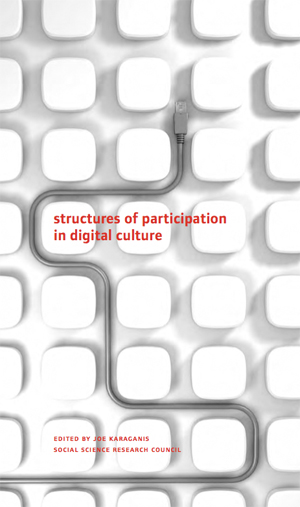Social Science Research Council | New York 2007 | 284 pages | ISBN 978-0-9790772-2-7
The entire book is available online.
 Structures of Participation in Digital Culture is a reader on the topic of private and public involvement with digital culture. Editor Joe Karaganis promises the reader of the book from the start that he will find different ways of going about the subject, in stead of just the known approaches originating from the fields of scholarly law, technology and media. Also, already from the beginning he states there is no answer to the question of causality when looking at cultural and technological change: no chickens, no eggs. That, for me, is a nice start. So let's have a look at what the book further does with these promises.
Structures of Participation in Digital Culture is a reader on the topic of private and public involvement with digital culture. Editor Joe Karaganis promises the reader of the book from the start that he will find different ways of going about the subject, in stead of just the known approaches originating from the fields of scholarly law, technology and media. Also, already from the beginning he states there is no answer to the question of causality when looking at cultural and technological change: no chickens, no eggs. That, for me, is a nice start. So let's have a look at what the book further does with these promises.Structures of Participation is divided into three main parts: Alternative Geographies, Public Lives of Users and Corporate Architecture. They all highlight a different aspect of the discussion.
In the first part, the book looks at the ways in which we perceive the world, in which we perceive history in this digital age. In stead of looking at successive change, it is explored how people nowadays experience and construct the past differently. Databases play a big part in this construction play. On the other hand piracy and the so called ‘copy culture’ undermine a coherent view of any entity, such as the past or culture.
Part two mainly focuses on case studies of private and public engagement with social technology. Social technology here should not only be interpreted as the digital platforms, but also the part which physical networking plays, especially in more playful practices such as games. Even the complex ways in which people represent themselves within these social networks can be viewed as a game, one where people play with their representations and relations to the physical world. The play again goes further though, because real-world relationships can be influenced by the ways in which interpersonal relations are represented on digital social platforms. The one-level representation of links to all kinds of related people, can never do justice to the mutli-layer connections that you hold outside of the internet.
The last part refocusses on law and technology, contextualizing the topics treated in the book so far. We look at knowledge production and consumption, the impact communities like Wikipedia have on our appreciation of expertise and what this means means for authorship. The gaming world as mentioned in the second part, is put into a technological context. In all the excitement of the social networking possibilities, we should not forget that it’s not just about how you represent yourself and how other media play a part in the whole experience. There is still the technology that must enable it. And as long as hardware and software are build within their own set of wishes and limitations, people will still be limited in their online presence due to this, true networking and connecting beyond boundaries cannot be achieved.
For me, Joe Karaganis sticks to his promise. The approaches are very divers, not only in their point of view, but also in their presentation to the reader. Some texts are case studies, others are like notes to oneself. This gives it all a very accessible feel. The mix of shorter and longer texts further contribute to this. The tone-of-voice is pleasantly non-scholarly, but make no mistake, the book is not a simple read. The base is still academic and it’s definitely interesting for scholars. One look at the list of contributors shows that most of them are in fact professors, others are otherwise involved in (academic) research.
It's already back in 2007 when the Social Science Research Council (SSRC) published the reader 'Structures of Participation in Digital Culture'. The SSRC is a nonprofit organization based in New York, their focus is mainly on social science, but they stimulate an interdisciplinary approach. Joe Karaganis, the editor of the book, is a program director at the SSRC, where he mainly works in the field of media, technology and culture.
Geen opmerkingen:
Een reactie posten